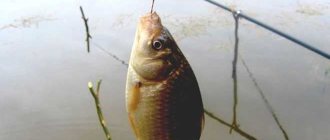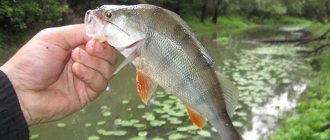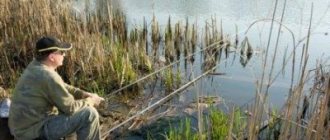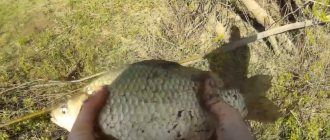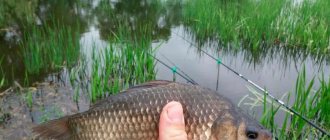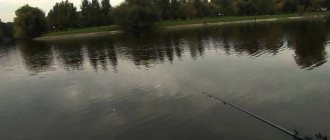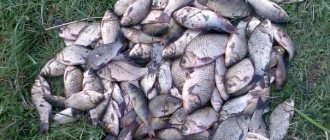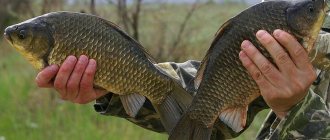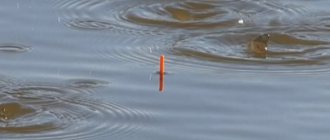Where to look for crucian carp
Crucian carp is a member of the carp family and belongs to the genus of ray-finned fish. The habitats of this species are very diverse.
Crucian carp are found in:
- ponds;
- lakes;
- swamps;
- flooded quarries;
- backwaters of rivers;
- ducts
This prevalence is due to the high degree of survival of the representative of the carp family in any conditions. This fish does not require an abundance of oxygen; even in swampy ponds that freeze to the very bottom, crucian carp can hide at the bottom and overwinter. But it should be noted that the crucian carp changes its location from time to time, doing this with the aim of searching for new profit and procreation.
In winter, this species burrows deep into the silt, so the places where it accumulates the most are the depths and depressions at the bottom. With the arrival of spring, the fish begin to swim out in search of remnants of plant food and move to the edges. April is considered the opening month of the fishing season for crucian carp; during this period it is active in bays and shallow ponds with thickets of reeds, which have a depth of no more than 1–1.5 m.
From the end of spring and the beginning of the summer season, this type of fish begins to spawn, so thickets of reeds and places near snags become its permanent habitat. The most catchy period for catching crucian carp is August, when the fish are most active in search of food. With the arrival of autumn, a representative of the carp family smoothly moves to deeper areas of reservoirs.
The correct leash for crucian carp
Each rig has a leash - a fairly important part of it. Installing leashes on crucian carp is not always easy and simple, since during installation you need to know their exact length, combination with the type of fishing line, fastening methods, etc.
Why do you need a leash when fishing for crucian carp?
A leash during crucian carp fishing is necessary to perform a number of functions:
- make the fishing line more invisible;
- in the presence of a blind hook or in the event of a large bite, it allows you to save both the sinkers and the float;
- helps lures and bait look as natural as possible in the water.
Leash length
After the type of fishing line used is determined, the length of the leash is selected:
- for a float rod - from fifteen to thirty centimeters;
- for elastic - from ten to thirty centimeters;
- for the crown - no more than seven centimeters;
- for the feeder - from twenty to eighty centimeters.
It is important to remember: short leashes increase the resistance of the gear, and the crucian carp can throw the bait. Using the longest possible leashes can also adversely affect the quality of the bite.
Leashes in the “spring” and “top” rigs
“Spring” is a well-known method of catching crucian carp; it uses a feeder (spring) with many hooks on which foam balls are placed. There is complementary food in the feeder. The fish gradually releases all the hooks and mistakenly sucks them in. For this type of fishing, a fishing line (main) with a diameter of 0.25 to 0.40 mm is used, and for leashes it is recommended to use braid with a diameter of 0.04 to 0.10 mm.
The “makushatnik” is made like a spring, but both the bait and the groundbait are in one piece. For this type of gear, a main thread with a diameter of 0.35 mm is used, and for leashes a braid with a diameter of 0.18 mm is used.
How to knit leashes and hooks for catching crucian carp
Let's consider an example on a fishing line with a length of one hundred and twenty centimeters. At the end you need to make a loop about eleven centimeters, and on the loop - a double, well-tightened knot. You need to pass the loop through the special holes on the weights twice. Pull the opposite edge of the fishing line into the resulting eyelet and tighten it carefully. Now let's move on to the hooks and leash. We take three hooks and fishing line for the leash. We attach the hook to five turns of fishing line and make a strong knot on the hook. Gradually you need to attach all the hooks to the leashes. Determine the length of the leash. Using a figure eight knot, we attach the leash to the main line. Thus, there will be three leashes with hooks on the fishing line. You can watch a video on the Internet to make the process clearer.
Which fishing rod to choose for catching crucian carp
The float rod is the most common among fishermen. It became so thanks to its ease of use and practicality. This rod can be used everywhere: from a boat, bridge, shore, and is easy to equip. Below is a description of the most practical and affordable options for float rods.
Flywheel
A fly rod is a device for fishing. The tackle has no excess in its design, which makes it easy to assemble. To install it, you will need to tie a fishing line to the end of the fishing rod with a weight, hook and float attached to it. This type of gear is especially effective during active fishing. The minimum weight of the fishing rod prevents the fisherman from getting too tired. This gear also makes it possible to use a fishing line with a small diameter, only 0.15 mm, which allows you to react more quickly to a bite and hook fish.
Bologna
Bolognese tackle has a telescopic design. Its length, depending on the model, can be 5–7 m and rarely - 4 m and 8 m. The rod has rings, the number of which must correspond to the number of legs. The fishing rod has a couple more rings located at the very peak; they are designed to relieve the tip of the fishing rod when landing fish.
To prevent wet fishing line from sticking to the form, guide rings must be installed on high legs.
Match
The match tackle has a plug connection 3.6–4.8 m long. This rod contains 3–4 elbows and 12–16 small guide rings on a long leg. This design provides stability and strength.
Find out more about how to prepare pearl barley for fishing in a thermos.
Components of a match fishing rod:
- float;
- sinking line;
- spinning reel;
- sinker;
- leash;
- hook;
- rod
Pikernaya
Picker gear is designed for biting from the bottom. This fishing rod allows you to catch crucian carp from any distance.
You will be interested to know how to prepare wheat for crucian carp fishing.
For equipment you will need:
- rod 3.3 m long;
- spinning reel;
- feeder weighing 40 g;
- fishing line;
- leash;
- hook.
The choice of fishing line depending on the gear used
Fishing line for crucian carp. Feeder and “crucian carp killer”, donka
Bottom fishing for crucian carp most often involves long casting . It is this fact that makes us give preference to braided line , because with a long line length - from 50 m - the monofilament line will spring and stretch, which makes handling the tackle difficult. But the braided line , which practically does not stretch , will better signal a bite, as well as ensure self-hooking of the crucian carp.
However, it is worth paying attention to the bottom of the reservoir - if it is rocky , and the stones have sharp edges, it is better to give preference to monofilament fishing line, since the braided line will cling to the stones and wear out very quickly.
Also, monofilament fishing line will be better when catching trophy crucian carp on the bottom, because it will dampen sharp jerks of the fish being caught due to its elasticity.
Fishing line for catching crucian carp on a float rod
When fishing with a float rod near the shore, the stretchability of the monofilament line will not be very pronounced, since its length will be relatively short, which determines it as the best option .
However, when fishing among windows of vegetation , as well as in snags , it is better to put a braided line .
Fishing line for crucian carp, what should it be?
How to rig a fishing rod
It is necessary to choose equipment with particular scrupulousness, because the outcome of the fishing will depend on it. All parts of the fishing rod must be durable and of high quality. If the fisherman is new to this field, then when choosing components for the tackle, you can consult with a specialist. Read on to learn how to equip a fishing rod.
Find out more about how to catch crucian carp in June using a float rod.
Hook
Hooks are usually chosen for bait. If fishing is carried out with a worm, then you should take an extended tackle with a hook. Dough or maggot bait should be placed on small hooks. According to world classification standards, such equipment for catching crucian carp should have number sizes from 8 to 12.
Coil
Reels come in inertia-free and conventional types. They are selected depending on the type of fishing rod and the thickness of the fishing line. Usually, when fishing for crucian carp, reels made of plastic are used. They are lighter and will not weigh down the rod.
fishing line
The fishing line must be strong and of high quality, which will ensure a good catch. Its susceptibility to deformation is minimal. The thickness of this equipment is selected depending on which body of water and at what time of year the fishing will be done. For standing water, take a fishing line with a thickness of 0.2 mm, and for snags - 0.35 mm.
Float
To bite crucian carp, you need to choose thin, elongated floats. For this purpose, you can use purchased gear or bird feathers, for example, a goose. Floats of this structure are very sensitive, so they are an excellent indication of the bite. Everything happens thanks to their special sensitivity and lightness.
Sinker
It is best to use lead pellets as a load. There should be 2–3 of them, they are located close to each other. There should be a distance of 20–25 cm between the sinker and the hook. If all the angler’s hooks are unsuccessful, then the weight should be positioned a little higher. If the crucian carp eats the bait and the float does not respond to its actions, you need to move the pellets lower.
Stop Beads/Knots
To fix the immersion depth of the tackle, you need to use a stop bead or knot. They are attached to the main line and must have freedom of movement. The bead is a ball made of rubber. It should easily pass through the passage rings. The knot is tied from fishing line or silicone thread.
How to choose fishing line for a float rod
Let's get down to specifics. There are three types of fishing lines that are used for float fishing - monofilament, fluorocarbon and braided. Let's look at each of them.
Tips for fisherman: Which fishing line for crucian carp is the best diameter - All the nuances
Network.
This fishing line is used the least often, as it is thick and quite rough, and if used improperly, it can scare away all the fish. But this line is very strong, and the rod is more likely to break than such a line to break. The advantages also include:
Minimal play - with such a line, even the most timid bite will be noticeable, since it practically does not stretch. When tangled, if you do not tighten the knots, it is very easy to untangle due to its rigidity. For the same reason, it does not cake and will not curl in rings when unwinding.
This type of fishing line also has many disadvantages:
After several fishing trips, the braid will become shaggy, the reason is constant friction. As a result, the cord in the water becomes three times more visible.
Even the light version of this line is very noticeable in clear water.
The high cost of braided fishing line is not justified if you plan to use a float fishing rod, since with this type of fishing it wears out extremely quickly.
It is best to choose monofilament
What bait to use
Crucian carp is an undemanding fish that can survive in almost any conditions. The diet of this species is very diverse and depends on the habitat, so bait of plant and animal origin can be used to catch crucian carp.
To produce a bite, use the following products:
- legumes - peas, corn;
- cereals - millet, barley, wheat;
- boiled porridge - semolina, oatmeal;
- dough made from wheat and corn flour.
Should I use fragrances?
The flavoring is used if the bite is below average. In this case, you can use store-bought or natural flavorings. The commercial flavoring is created on the basis of enzymes, and the natural one is added to various mixtures and baits.
Natural flavoring can be:
- sunflower oil (not refined);
- hemp oil;
- anise oil;
- vanillin;
- garlic or dill, parsley is also suitable.
Any flavoring, when used correctly, increases the chances of catching, but at the same time it is necessary to take into account the characteristics of the reservoir:
- The presence of certain objects nearby that affect the smell of water in a reservoir, for example, if there is a poultry farm nearby, bird droppings can be added to the bait.
- Availability of fish species that can eat bait. For example, in such cases special pheromones are often used that attract only crucian carp.
- Availability of food for crucian carp in its habitat, that is, a reservoir.
Tactics for catching crucian carp with a float rod
When biting, the float should be correctly loaded, i.e. the mass of the sinker should be such that only the working part of the float antenna is visible above the water surface. It is usually easy to notice because it has a bright color. In order not to make a mistake when choosing a float, you should pay attention to the indicator of its weight and the recommended weight of the sinker. These values are indicated on the surface of the tackle.
Crucian carp, like any other fish, is cautious and timid, so to bite it you will need the correct, quick reactions of the fisherman, as well as coordination of movements. His hands must always be ready to pull out the fishing line, and with it the prey.
Having determined the place where fish accumulate, it is necessary to feed them. Baits are scattered within a radius of 80–100 cm from the intended fishing and only after that they begin to directly cast the gear. Experienced fishermen advise not to rush into hooking crucian carp, because this fish is not inclined to quickly grab the bait. If there is a weak float signal, it means you need to take out the fishing rod after 2-3 seconds.
Important! The mouth cavity of a crucian carp is very weak, so if fished very quickly, it can fall off the hook.
General recommendations for anglers:
- Smoking is not allowed at the fishing site, as cigarette smoke scares away the fish.
- If you do not maintain silence on the shore or in the boat, then there will be no catch, because crucian carp react to literally any noise.
Length of leashes for feeder fishing for crucian carp
The most difficult thing is to choose leashes for catching crucian carp on a feeder. We have already noted above that their length can vary from 20 to 80 cm. Moreover, some fishermen use longer leash structures (about 1 m) on the English donka. Therefore, the logical question becomes: “How do you understand what length of fishing line should be on the leashes on the feeder?”
Many will say that the larger it is, the better. But that's not true. The leashes on the feeder simply do not have the correct length. The fact is that it depends on many factors:
- places on a body of water;
- bottom features;
- season;
- water and air temperatures;
- weather conditions;
- current forces;
- sensitivity of gear and rod;
- habits and preferences of the fish itself.
When choosing the length of the feeder leads, a number of features should be taken into account
This list could go on for quite a long time. Therefore, experienced fishermen, coming to a reservoir, constantly experiment with the length of leashes. Otherwise, catching crucian carp on a feeder, especially large ones, can sometimes be difficult. However, by choosing the optimal length of fishing line from the feeder to the hooks with nozzle, you can count on a good catch.
Of course, usually leashes are placed on the feeder, the length of which is about 40 cm. Most often, this is enough to place the bait not close to the feeder, but so that it is in the field of view of the crucian carp attracted by the bait. But it also happens that fish only bite on feeder equipment with short (about 20 cm) or, conversely, long (about 80-100 cm) leashes. So anglers have to constantly try different options.
Features of fishing with two hooks
The presence of a second hook on the fishing rod will significantly increase the chance of a good bite. With its help, experienced fishermen also determine the food preferences of crucian carp. They put live bait, such as a worm, on the first hook, and vegetable bait on the second. To achieve a good bite on two hooks, you need to install them correctly. To do this, you can use a fastening method called “loop to loop”.
Video: Leash with two hooks
Hooks can be attached to different leashes or placed on the same line, only with a small distance between them. The methods of attachment will depend on the body of water and the dexterity of the fisherman. For strong currents, it is better to use the option of placing hooks on one line, then you will not have to constantly untangle the intertwined leashes.
Did you know? The crucian carp has a very developed sense of smell, so it is often lured by unusual smells, such as valerian, corvalol or kerosene.
Crucian carp is a popular fish; it can be found in almost every body of water. With the right equipment and fishing tactics, even a beginner in fishing can cope with catching this type of fish.
My fishing tips
I wish you good health. My mounting pattern for a float rod depends on the overall length of the fly rod and the sensitivity of the tip, which must be taken into account when tying a rig with two hooks. Many fans of Bolognese-type float rods prefer to fish with a float with one mount, a main lead weight (pellet) and one hook. What works great for fishing on ponds, rivers and reservoirs is great for long-distance casting of float equipment.
photo - My installation diagram for a float fishing rod - https://moisovetyorybalke.ru/
- A 2.4-meter fly rod is suitable for fishing in a ditch, where large crucian carp can live, and in the summer, in such a water canal, aquatic grass grows above the water. Thus, the result of fishing in such reservoirs outside the city limits or within the city cannot be excluded.
photo - My installation diagram for a float rod - https://moisovetyorybalke.ru/
The total length of the fly rod is 2.4 meters.
- The fly rod is 2.4 meters long, consists and is assembled from elbows hidden inside the rod holder, which will not be difficult to assemble the equipment with a float with two hooks yourself.
- The fishing store will have to look for a 2.4 meter fly rod, a mini float, lead shot, the main fishing line in a 30 meter reel with a diameter of 0.12 mm to 0.14 mm, a pack of earthworms and a mini landing net with a 1.5 meter handle for landing crucian carp on the shore.
- We buy a reel separately for transporting fishing tackle.
photo - My installation diagram for a float fishing rod - https://moisovetyorybalke.ru/
How to properly assemble a float fishing rod with two hooks for crucian carp + my installation diagram
photo - My installation diagram for a float fishing rod - https://moisovetyorybalke.ru/
- A 2.4 meter fly rod with test weight from 10 grams to 25 grams, you need to look at which one to choose on the spot when purchasing at a fishing store.
photo - My installation diagram for a float fishing rod - https://moisovetyorybalke.ru/
- The main fishing line is 1.2 meters; when assembling the installation of the tackle, you need to initially take a reserve of up to 1.4 meters. I use the diameter of the main line from 0.12 mm to 0.14 mm, monofilament line, iguana brand.
- In my diagram I will describe the assembly of a fly fishing rod with two hooks without the use of a leading line.
photo - My installation diagram for a float fishing rod - https://moisovetyorybalke.ru/
- On the main line we make a loop using a figure eight fishing knot.
- We measure 1.2 meters, where we measure the main line with a margin and leave it to the base of the fishing rod holder.
- We put on any of the floats weighing up to 2 grams; you need to look for which one to choose when buying a fly fishing rod.
photo - My installation diagram for a float fishing rod - https://moisovetyorybalke.ru/
- At the end of the fishing rod, measure the total length and knit a loop from a figure eight knot.
- Separately, up to approximately 12 cm to 15 cm, we knit medium-sized fishing hooks for crucian carp.
- First, I tie the leading line to the shank of the hook using a “universal knot” fishing knot.
- Approximately measure the total length for two hooks and proceed to knitting the second fishing hook.
photo - My installation diagram for a float fishing rod - https://moisovetyorybalke.ru/
- When the leash line is connected to two fishing hooks, it is necessary to distribute the distance between the hooks and their height.
photo - My installation diagram for a float fishing rod - https://moisovetyorybalke.ru/
- Now in the place of the folded fishing line we knit a figure eight knot in the form of a loop.
- We connect the loop into a loop with the main fishing line.
photo - My installation diagram for a float fishing rod - https://moisovetyorybalke.ru/
- The lead weight must be used with a lead pellet and secured at the loop-to-loop connection point.
photo - My installation diagram for a float fishing rod - https://moisovetyorybalke.ru/
- All that remains is to attach the earthworm to the fishing hooks and adjust the level of immersion of the float in the water.
photo - My installation diagram for a float fishing rod - https://moisovetyorybalke.ru/
Donate for development - for Christ's sake!
https://money.yandex.ru/to/41001136019007
Was the fishing information useful? Put ??????
??? Share a recent article??

